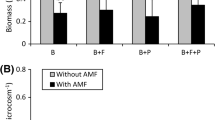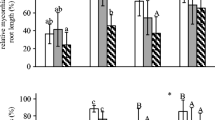Abstract
Two microcosm experiments were conducted to study the role of extraradical mycelium (ERM) of arbuscular mycorrhizal fungi (AMF) in establishment and growth of tree species used for revegetation in anthropogenic substrates. Inoculated or non-inoculated Acer pseudoplatanus, Alnus glutinosa or Salix purpurea seedlings were grown with Calamagrostis epigejos (a grass spontaneously colonising degraded ecosystems) in two substrates (fly ash and coal mine spoil) either in direct root contact or in rhizoboxes with interaction only via ERM network.
In both experiments, inoculation with AMF mostly had a positive effect on the growth of trees and increased the aggregation of fly ash. When plants grew in direct root-to-root contact, grass presence negatively affected tree growth, but it significantly improved mycorrhizal development (colonization of tree seedlings, spore number and ERM length). When grass and tree roots interacted via the ERM network, tree seedlings were successfully colonised by the ERM spreading from the C. epigejos roots. Mechanical disturbance of the ERM links between plants reduced AMF development and tree height in both substrates, but tree shoot biomass was not affected. In fly ash, inoculated, non-disturbed treatments showed significant transfer of 32P from the grass to the tree seedlings.
It can be concluded that roots of A. pseudoplatanus, A. glutinosa or S. purpurea seedlings can be colonised from the ERM network radiating from quickly growing grasses, which can act as important agents for AMF distribution and facilitate mycorrhization of planted trees. In particular for willow, grass seems to be an essential nurse plant to achieve successful root colonisation.
Similar content being viewed by others
References
Baker, D. D. and Schwintzer, C. R.: 1990, ‘Introduction’, in C. R. Schwintzer and J. D. Tjepkema (eds), The Biology of Frankia and Actinorrhizal Plants, Academic Press, San Diego, pp. 1–13.
Brundrett, M., Melville, L. and Peterson, R. L.: 1994, Practical Methods in Mycorrhizal Research, Mycologue Publications, Waterloo, Canada, pp. 80.
Call, C. A. and Davies, F. T.: 1988, ‘Effects of vesicular-arbuscular mycorrhizae on survival and growth of perennial grasses in lignite overburden in Texas’, Agric. Ecosyst. Environ. 24, 395–405.
Carrillo-García, A., Leon de la Luz, J. L., Bashan, Y. and Bethlenfalvay, G. J.: 1999, ‘Nurse plants, mycorrhizae, and plant establishment in a disturbed area of the Sonoran Desert’, Rest. Ecol. 7, 321–335.
Dhillion, S. S.: 1994, ‘Ectomycorrhiza, Arbuscular Mycorrhiza and Rhizoctonia sp. of Alpine and Boreal Salix spp. in Norway’, Arct. Alp. Res. 26, 304–307.
Evans, D. G. and Miller, M. H.: 1990, ‘The role of the external mycelial network in the effect of soil disturbance upon vesicular-arbuscular mycorrhizal colonization of maize’, New Phytol. 114, 65–71.
Enkhtuya, B., Óskarsson, Ú., Dodd, J. C. and Vosátka, M.: 2003, ‘Inoculation of grass and tree seedlings used for reclaiming eroded areas in Iceland with mycorrhizal fungi’, Folia Geobot. 38, 209–222.
Francis, R. and Read, D. J.: 1994, ‘The contribution of mycorrhizal fungi to the determination of plant community structure’, Plant Soil 159, 11–25.
Gerdemann, J. W. and Nicolson, T. H.: 1963, ‘Spores of mycorrhizal Endogone species extracted from soil by wet-siewing and decanting’, Trans. Br. Mycol. Soc. 46, 235–244.
Giovanetti, M. and Mosse, B.: 1980, ‘An evaluation of techniques for measuring vesicular-arbuscular infection in roots’, New Phytol. 84, 489–500.
Grime, J. P., Mackey, J. M. L., Hillier, S. H. and Read, D. J.: 1987, ‘Floristic diversity in a model system using experimental microcosms’, Nature 328, 420–422.
Heap, A. J. and Newman, E. I.: 1980a, ‘Links between roots by hyphae of vesicular-arbuscular mycorrhizas’, New Phytol. 85, 169–171.
Heap, A. J. and Newman, E. I.: 1980b, ‘The influence of vesicular-arbuscular mycorrhizas on phosphorus transfer between plants’, New Phytol. 85, 173–179.
Heijden van der, E. W.: 2000, ‘Mycorrhizal symbioses of Salix repens: Diversity and functional significance’, PhD. Thesis, Wageningen University, Subdepartment Soil Quality, The Netherlands.
Hille, M. and den Ouden, J.: 2005, ‘Charcoal and activated carbon as adsorbate of phytotoxic compounds, a comparative study’, Oikos 108, 202–207.
Ikram, A., Jensen, E. S. and Jakobsen, I.: 1994, ‘No significant transfer of N and P from Pueraria phaseoloides to Hevea brasiliensis via hyphal links of arbuscular mycorrhiza’, Soil Biol. Biochem. 26, 1541–1547.
Jakobsen, I., Abbott, L. K. and Robson, A. D.: 1992, ‘External hyphae of vesicular-arbuscular mycorrhizal fungi associated with Trifolium subterraneum L. 1. Spread of hyphae and phosphorus inflow into roots’, New Phytol. 120, 371–380.
Jasper, D. A., Abbott, L. K. and Robson, A. D.: 1989, ‘Soil disturbance reduces the infectivity of external hyphae of vesicular-arbuscular mycorrhizal fungi’, New Phytol. 112, 93–99.
Jenkins, W.: 1964, ‘A rapid centrifugal flotation technique for separating nematodes from soil’, Plant Dis. 48, 692–696.
Jeffries, P. and Barea, J. M.: 2001, ‘Arbuscular mycorrhiza: A key component of sustainable plant-soil ecosystems’, in B. Hock (ed), The Mycota Vol. IX. Fungal Associations, Springer, Berlin Heidelberg New York, pp. 95–113.
Johansen, A. and Jensen, E. S.: 1996, ‘Transfer of N and P from intact or decomposing roots of pea to barley interconnected by an arbuscular mycorrhizal fungus’, Soil Biol. Biochem. 28, 73–81.
Johansen, A., Finlay, R. D. and Olsson, P. A.: 1996, ‘Nitrogen metabolism of external hyphae of the arbuscular mycorrhizal fungus Glomus intraradices’, New Phytol. 133, 705–712.
Khan, A. G.: 1981, ‘Growth responses of endomycorrhizal onions in unsterilized coal waste’, New Phytol. 87, 363–370.
Koske, R. E. and Gemma, J. N.: 1989, ‘A modified procedure for staining roots to detect VA mycorrhizas’, Mycol. Res. 92, 486–505.
Kovář, P.: 2004, Natural Recovery of Man-Made Deposits in Landscape (Biotic interactions and ore/ash-slag artificial ecosystems), Academia, Praha, pp. 358.
Lumini, E., Bosco, M., Puppi, G., Isopi, R., Frattegiani, M., Buresti, E. and Favilli, F.: 1994, ‘Field performance of Alnus cordata Loisel (Italian alder) inoculated with Frankia and VA-mycorrhizal strains in mine-spoil afforestation plots’, Soil Biol. Biochem. 26, 659–661.
Malcová, R., Vosátka, M. and Albrechtová, J.: 1999, ‘Influence of arbuscular mycorrhizal fungi and simulated acid rain on the growth and coexistence of the grasses Calamagrostis villosa and Deschampsia flexuosa’, Plant Soil 207, 45–57.
Malcová, R., Albrechtová, J. and Vosátka, M.: 2001, ‘The role of extraradical mycelium network of arbuscular mycorrhizal fungi on establishment and growth of Calamagrostis epigejos in industrial waste substrates’, Appl. Soil Ecol. 18, 129–142.
Maldonado, J. D., Tainter, F. H., Skipper, H. D. and Lacher, T. E.: 2000, ‘Arbuscular mycorrhiza inoculum potential in natural and managed tropical montane soils in Costa Rica’, Trop. Agricul. 77, 27–32.
Martins, M. A.: 1993, ‘The role of the external mycelium of arbuscular mycorrhizal fungi in the carbon transfer process between plants’, Mycol. Res. 97, 807–810.
Martins, M. A. and Read, D. J.: 1996, ‘The role of the external mycelial network of arbuscular mycorrhizal (AM) Fungi. II. A study of phosphorus transfer between plants interconnected by a common mycelium’, Rev. Microbiol. 27, 100–105.
Miller, S. L. and Allen, E. B.: 1992, ‘Mycorrhizae, nutrient translocation, and interactions between plants’, in M. F. Allen (ed), Mycorrhizal Functioning: An Integrative Plant-Fungal Process, Chapman & Hall, New York, pp. 301–332.
Miller, M. R. and Jastrow, J. D.: 1992, ‘The application of VA mycorrhizae to ecosystem restoration and reclamation’, in M. J. Allen (ed), Mycorrhizal Functioning An Integrative Plant-Fungal Process, Chapman and Hall, New York, pp. 488–517.
Miller, R. M. and Lodge, D. J.: 1997, ‘Fungal responses to disturbance: Agriculture and forestry’, in Wicklow and Söderström (eds), The Mycota IV. Environmental and Microbial Relationships, Springer Verlag, Berlin, Heidelberg.
Molina, R., Myrold, D. and Li, C. Y.: 1994, ‘Root symbiosis of red alder: Technological opportunities for enhanced regeneration and soil improvement’, in D. E. Hibbs, D. S. DeBell and R. F. Tarrant (eds), The Biology and Management of Red Alder, Oregon State University Press, Corvallis, Oregon, pp. 23–46.
Monar, I.: 1972, ‘Analyseautomat zur simultanen Mikrobestimmung von C, H und N’, Mikrochimica Acta. 6, 784–806.
Moore, P. D. and Chapman, S. B.: 1986, Methods in Plant Ecology Blackwell Scientific Publications, Oxford.
Newman, E. I., Devoy, C. L. N., Easen, N. J. and Fowles, K. J.: 1994, ‘Plant species that can be linked by VA mycorrhizal fungi’, New Phytol. 126, 691–693.
Olsen, R. S.: 1954, ‘Estimation of available phosphorus in soils by extraction with sodium bicarbonate’, U.S. Dept. Agric. Stat., No. 939.
Pérez-Solís, E., Barea, J. M. and Vosátka, M.: 2000, ‘The role of extraradical mycelium of indigenous AMF in the interaction of vegetation on degraded Mediterranean ecosystems’, in Abstract Book of COST Action 838, Faro, Portugal, pp. 44.
Prach, K.: 1987, ‘Succession of vegetation on dumps from strip coal mining’, Folia Geobot. 22, 339–354.
Renker, C., Zobel, M., Opik, M., Allen, M. F., Vosátka, M., Rydlova, J. and Buscot, F.: 2004, Structure, Dynamics, and Restoration of Plant Communities: Do Arbuscular Mycorrhizae Matter?, Island Press, Washington, Covelo, London, pp. 189–229.
Rillig, M. C., Wright, S. F. and Eviner, V. T.: 2002, ‘The role of arbuscular mycorrhizal fungi and glomalin in soil aggregation: Comparison effects of five plant species’, Plant Soil 238, 325–333.
Robles Pérez, C.: 1999, ‘Modificación de las propiedades físicas, químicas y biológicas de suelos en respuesta a la actividad de organismos simbióticos y rizosféricos, en el contexto de una agricultura sostenible’, PhD Thesis, Universidad Politécnica de Madrid.
Struková, S., Vosátka, M. and Pokorný, J.: 1996, ‘Root symbioses of Alnus glutinosa (L.) Gaertn. and their possible role in alder decline: A preliminary study’, Folia Geobot. Phytotax. 31, 153–162.
Sylvia, D. M.: 1988, ‘Activity of external hyphae of vesicular – arbuscular mycorrhizal fungi’, Soil Biol. Biochem. 20, 39–43.
Sylvia, D. M. and Williams, S. E.: 1992, ‘Vesicular-arbuscular mycorrhizae and environmental stresses’, in G. J. Bethlenfalvay and R. G. Linderman (eds), Mycorrhizae in Sustainable Agriculture. ASA No 54, Madison, Wisconsin, pp. 101–124.
Tisdall, J. M.: 1991, ‘Fungal hyphae and structural stability of soil’, Aust. J. Soil Res. 29, 729–743.
Tisdall, J. M.: 1994, ‘Possible role of soil microorganisms in aggregation in soils’, Plant Soil. 159, 115–121.
Tisdall, J. M. and Oades, J. M.: 1979, ‘Stabilization of soil aggregates by the root systems of ryegrass’, Aust. J. Soil Res. 17, 429–441.
Tisserant, B., Gianinazzi-Pearson, V., Gianinazzi, S. and Golotte, A.: 1993, ‘In planta histochemical staining of fungal alkaline phosphatase activity for analysis of efficient AM infection’, Mycol. Res. 97, 245–250.
Vosátka, M. and Dodd, J. C.: 1998, ‘The role of different arbuscular mycorrhizal fungi in the growth of Calamagrostis villosa and Deschampsia flexuosa, in experiments with simulated acid rain’, Plant Soil 200, 251–263.
Vosátka, M., Rydlová, J. and Malcová, R.: 1999, ‘Microbial inoculation of plants for revegetation of disturbed soils in degraded ecosystems’, in P. Kovář (ed), Nature and Culture in Landscape Ecology. Proceedings of the CZ-IALE Conference, Prague, pp. 303–317.
Wright, S. F. and Upadhyaya, A.: 1998, ‘A survey of soils for aggregate stability and glomalin, a glycoprotein produced by hyphae of arbuscular mycorrhizal fungi’, Plant Soil 198, 97–107.
Wright, S. F., Upadhyaya, A. and Buyer, J. S.: 1998, ‘Comparison of N-linked oligosaccharides of glomalin from arbuscular mycorrhizal fungi and soils by capillary electrophoresis’, Soil Biol. Biochem. 30, 1853–1857.
Author information
Authors and Affiliations
Corresponding author
Rights and permissions
About this article
Cite this article
Enkhtuya, B., Pöschl, M. & Vosátka, M. Native Grass Facilitates Mycorrhizal Colonisation and P Uptake of Tree Seedlings in Two Anthropogenic Substrates. Water Air Soil Pollut 166, 217–236 (2005). https://doi.org/10.1007/s11270-005-7273-0
Received:
Accepted:
Issue Date:
DOI: https://doi.org/10.1007/s11270-005-7273-0




